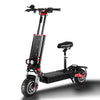The Future of Urban Mobility: Are Electric Scooters Here to Stay?
Once seen as a passing trend, electric scooters have now become a defining element of modern city life. From Barcelona to Buenos Aires, these compact, battery-powered machines are reshaping how we move. But are they just a temporary fad—or are they the cornerstone of future urban mobility?
The Rise of Micro-Mobility
The explosion of micro-mobility is no accident. Cities are facing:
Traffic congestion
Air pollution
Limited parking
Post-COVID transport anxiety
Electric scooters offer a low-cost, low-emission, and low-space alternative. They're fast, flexible, and eco-friendly—ticking every box for modern city dwellers.
Why Electric Scooters Are Here to Stay
Sustainability: Zero emissions during use. A key tool for cities aiming to meet climate goals.
Affordability: Once purchased, daily costs are minimal. No fuel. No parking fees.
Infrastructure: Bike lanes, scooter parking zones, and charging networks are expanding fast.
Policy support: Many governments now subsidize or promote scooter usage as part of green mobility initiatives.
Challenges That Must Be Solved
Regulatory clarity: Laws still vary wildly between regions.
Safety: Training, helmets, and tech-driven accident prevention must improve.
Theft and vandalism: A growing issue in some cities (GTXR offers GPS and locking solutions).
Battery sustainability: Eco-friendly recycling solutions must be scaled.
How GTXR Fits the Future
GTXR scooters are:
Built to last: With high-performance batteries and durable frames
Smart: With app connectivity, lock features, and performance stats
Compliant: Designed to meet local regulations in Europe, Latin America, and beyond
Sustainable: Lightweight, efficient, and recyclable components





